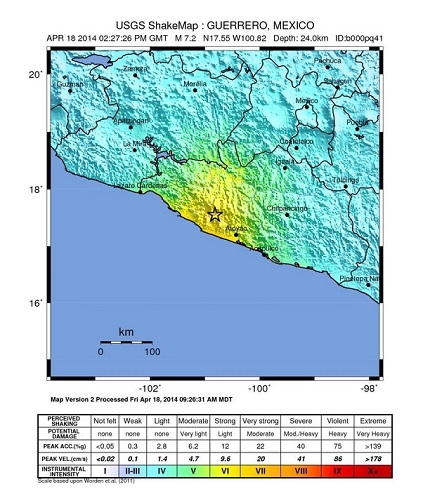Mexico Earthquake
Status: Closed
| Type of posting | Posting date(EST): | Summary | Downloads |
|---|---|---|---|
| First Posting | 4/18/2014 1:00:00 PM |
|
First Posting | Summary
Posting Date: April 18, 2014, 1:00:00 PM
Current Situation
On the morning of April 18, 2014, an M7.2 earthquake struck southwestern Mexico, 37 km north of the municipality of Tecpan de Galeana (approximate population 53,000). The epicenter is located 273 km southwest of Mexico City and lies between the resort cities of Acapulco and Zihuatanejo, where many residents and tourists are staying during the run-up to Easter. According to the United States Geological Survey (USGS), the earthquake occurred at 09:27:26 AM local time on April 18 (14:27:26 UTC) and struck at a depth of 24.0 kilometers. The U.S. Pacific Warning Center has issued a statement indicating that there is no tsunami threat.
As of midday on April 18, at least one building in Mexico City was damaged and there are several reports of broken windows. However, it is still in the early aftermath of this event and additional reports of damage may well come in. Nearer the epicenter, several residents have reported damage to masonry walls on older buildings, and to some contents inside apartment buildings.
Power outages are widespread and internet access is down in some areas. In Acapulco, the civil protection office sent a message over the internet indicating that basic services are in operation, with no reports of damage. There are reports of people trapped in elevators in Mexico City, but no serious injuries have been reported. Strong shaking was felt for at least 30 seconds in Mexico City, which was less crowded than usual due to the holiday; however, high rise buildings were evacuated. The earthquake was felt across a large region, affecting at least six states.
Seismicity of Mexico
Mexico, which lies along the boundaries of three tectonic plates, is very seismically active. The Middle America Trench, which is located along Mexico’s southern coast, is the subduction zone where the oceanic Cocos Plate subducts underneath the continental edge of the North American Plate. Subduction zones can generate large earthquakes when the subducting plate locks with the overlying plate and builds stress. The depth, location, and thrust-faulting source mechanism of today’s M7.2 earthquake suggest that it may be related to this subduction zone. Metamorphic changes in the downward-traveling slab also produce volcanic activity along the Cordilla Neovolcánica.
Mexico City is quite vulnerable to ground shaking even from distant earthquake events due to the local soil conditions, which include soft and muddy drained lake beds. In 1985, an M8.1 earthquake located 400 miles from Mexico City destroyed many of its buildings and killed over 9,500 people.
The USGS ShakeMap below provides information about the degree of shaking expected to have been felt in the epicentral region. It should be noted that the earthquake magnitude estimates provided by the USGS are indeed estimates and may change as additional information becomes available from seismic networks in the area.

MMI Map of Today’s Earthquake (Source: USGS)
Exposure
Today, the majority of residential buildings in Mexico are of masonry construction. Masonry buildings typically fall into one of three classifications: reinforced masonry, confined masonry, and unreinforced masonry. Unreinforced masonry buildings are one of the construction types most vulnerable to shake damage. Commercial buildings in Mexico are primarily of engineered masonry or concrete construction, and are better able to withstand ground motion.
In large urban areas, such as Mexico City, most middle- to upper-class families live in five- to fifteen-story tall reinforced concrete commercial dwellings. These buildings are generally well designed and built with high quality materials.
Due to the repetitive and destructive nature of earthquakes in Mexico, building codes in this country are among the most comprehensive in the world. However, there are no national codes. Instead, each of the more than 2,400 municipalities in Mexico enacts and enforces its own regulations. Among these municipalities, building code enforcement is often lacking; furthermore, designers and contractors often do not fully apply building regulations. Finally, local offices, particularly in small municipalities, typically are without a technical group to review structural design and inspect quality of construction, and thus, the seismic performance of buildings in Mexico is greatly influenced by local construction practices. Building damageability is exacerbated by poor workmanship and inadequate materials.
The AIR earthquake team is currently collecting the available information about this event and will provide additional information as warranted.